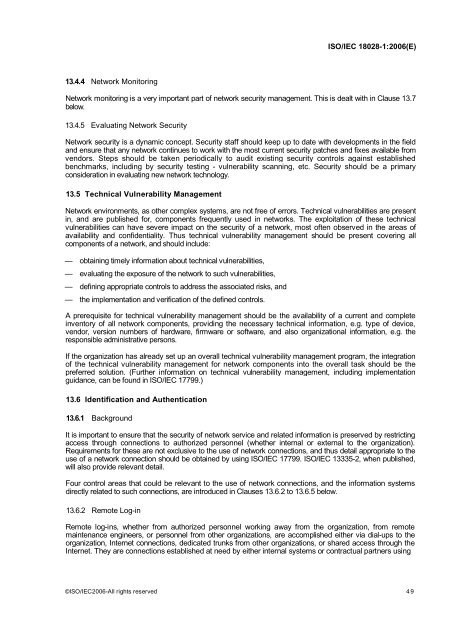INTERNATIONAL ISO/IEC STANDARD 18028-1
INTERNATIONAL ISO/IEC STANDARD 18028-1
INTERNATIONAL ISO/IEC STANDARD 18028-1
- No tags were found...
You also want an ePaper? Increase the reach of your titles
YUMPU automatically turns print PDFs into web optimized ePapers that Google loves.
<strong>ISO</strong>/<strong>IEC</strong> <strong>18028</strong>-1:2006(E)13.4.4 Network MonitoringNetwork monitoring is a very important part of network security management. This is dealt with in Clause 13.7below.13.4.5 Evaluating Network SecurityNetwork security is a dynamic concept. Security staff should keep up to date with developments in the fieldand ensure that any network continues to work with the most current security patches and fixes available fromvendors. Steps should be taken periodically to audit existing security controls against establishedbenchmarks, including by security testing - vulnerability scanning, etc. Security should be a primaryconsideration in evaluating new network technology.13.5 Technical Vulnerability ManagementNetwork environments, as other complex systems, are not free of errors. Technical vulnerabilities are presentin, and are published for, components frequently used in networks. The exploitation of these technicalvulnerabilities can have severe impact on the security of a network, most often observed in the areas ofavailability and confidentiality. Thus technical vulnerability management should be present covering allcomponents of a network, and should include:— obtaining timely information about technical vulnerabilities,— evaluating the exposure of the network to such vulnerabilities,— defining appropriate controls to address the associated risks, and— the implementation and verification of the defined controls.A prerequisite for technical vulnerability management should be the availability of a current and completeinventory of all network components, providing the necessary technical information, e.g. type of device,vendor, version numbers of hardware, firmware or software, and also organizational information, e.g. theresponsible administrative persons.If the organization has already set up an overall technical vulnerability management program, the integrationof the technical vulnerability management for network components into the overall task should be thepreferred solution. (Further information on technical vulnerability management, including implementationguidance, can be found in <strong>ISO</strong>/<strong>IEC</strong> 17799.)13.6 Identification and Authentication13.6.1 BackgroundIt is important to ensure that the security of network service and related information is preserved by restrictingaccess through connections to authorized personnel (whether internal or external to the organization).Requirements for these are not exclusive to the use of network connections, and thus detail appropriate to theuse of a network connection should be obtained by using <strong>ISO</strong>/<strong>IEC</strong> 17799. <strong>ISO</strong>/<strong>IEC</strong> 13335-2, when published,will also provide relevant detail.Four control areas that could be relevant to the use of network connections, and the information systemsdirectly related to such connections, are introduced in Clauses 13.6.2 to 13.6.5 below.13.6.2 Remote Log-inRemote log-ins, whether from authorized personnel working away from the organization, from remotemaintenance engineers, or personnel from other organizations, are accomplished either via dial-ups to theorganization, Internet connections, dedicated trunks from other organizations, or shared access through theInternet. They are connections established at need by either internal systems or contractual partners using©<strong>ISO</strong>/<strong>IEC</strong>2006-All rights reserved 49
















